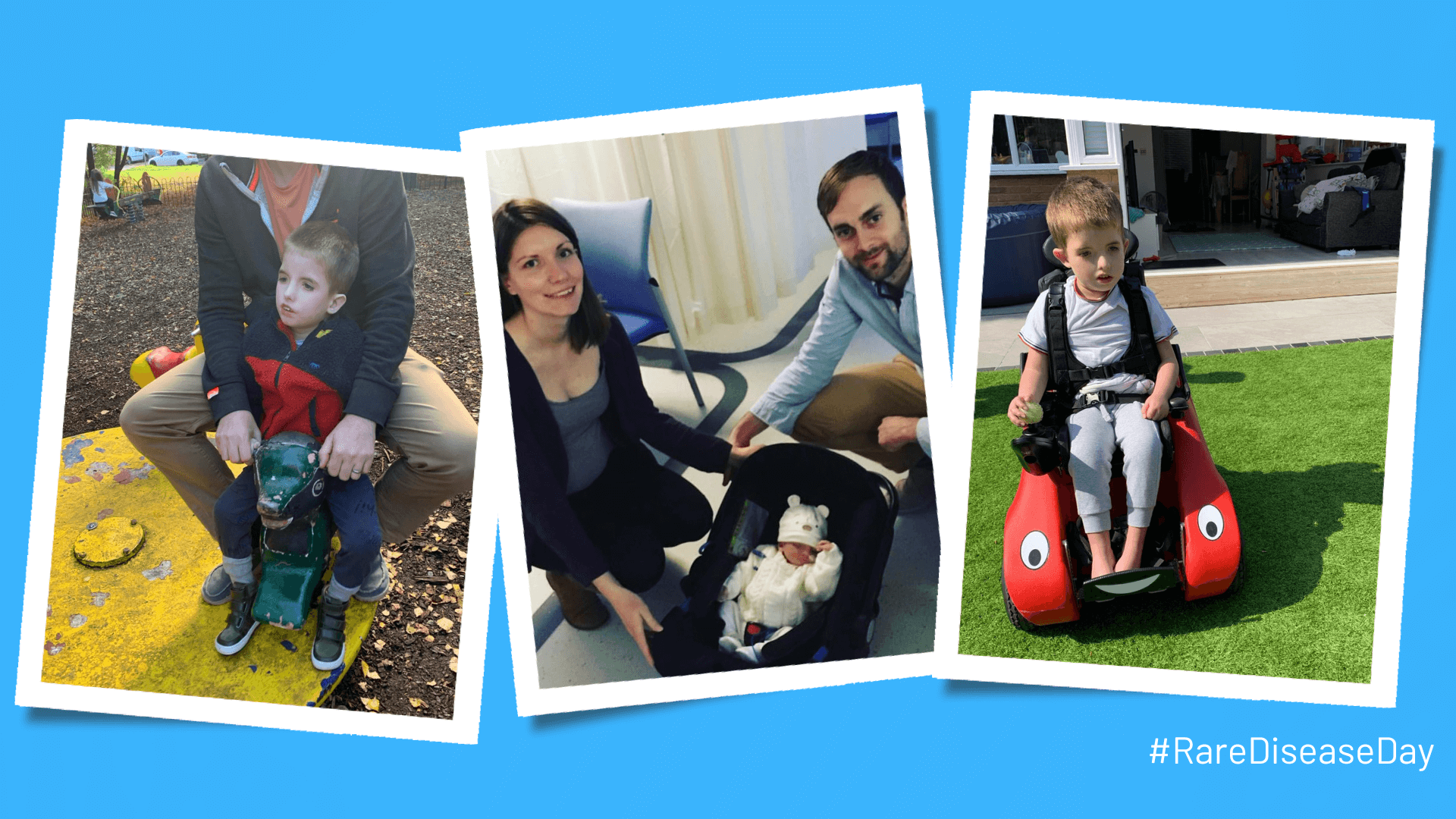Raising awareness of rare diseases can inspire positive change
While a single rare disease affects relatively few people, there are many different ones, and so the total number of people with one (between 260 and 440 million) is probably higher than you’d have thought.1 And since the impact of rare diseases also extends to family members and carers, rare diseases affect up to 1.4 billion people worldwide.1 That’s a lot of people.
As a scientist, CEO of a medical communications agency, and father of a rare little boy, I keep a keen eye on the latest research in rare diseases and genomics. To commemorate this Rare Disease Day, I’m sharing my personal story to raise awareness of rare diseases, provide comfort, and inspire positive change around the world.
My personal journey into rare diseases was a rollercoaster
There are few things in life that truly knock your socks off. Events that stay with you for the rest of your life, that you may later come to draw strength from in times of need. For me, presenting my Biomedical Sciences PhD research to a room full of 100 experts at Cambridge University; defending my PhD thesis; and that time I welcomed my son, Harry, into the world with a rare disease.
The latter becoming the ultimate sock blaster. No amount of scientific, educational, or professional medical background can prepare you for news like this. Once the shock subsides, uncertainty and helplessness begin to set in. An ordeal of doctors giving vague answers while running blood tests, muscle biopsies, brain scans—all delivered days later, but thankfully for us with a confirmed diagnosis: Moebius syndrome. Or so we thought.
Moebius syndrome is a rare condition mainly affecting the muscles that control facial expression and eye movement. It’s caused by the absence or underdevelopment of the sixth and seventh cranial nerves.
Managing Moebius syndrome and more
As the weeks and months passed since we found out that Harry had Moebius syndrome, and we got ‘used to’ our new way of living as a family, we began to feel more positive for the future. Despite his challenges, we thought that Harry would lead a relatively normal life, with typical physical strength, intelligence, and cognitive abilities.
So, we began to wonder what was happening when he began showing signs we weren’t expecting: why couldn’t he keep his milk down, why was he so weak, and why he couldn’t he communicate?
What hadn’t been considered (or determined) was that Harry had more than Moebius syndrome. And after reflecting on all the symptoms, we were told that Harry most likely has an additional rare condition that is undiagnosed. Nothing was picked up on the routine newborn screening, which only tests for a handful of diseases with a genetic component, and no other technologies were available to us at the time.
We’d experienced false hope and were rethrown into the unknown; conversations with our geneticist explaining that genetic testing was needed but that we’ll have to wait years to find answers, if at all.
Diagnosing and treating a rare disease can be difficult
Diagnosing and treating rare diseases is difficult, where a lack of research, awareness, and understanding often leads to misdiagnoses or delays in obtaining the correct diagnosis.
But recently, the field of rare diseases has been revolutionised by genomics and precision medicine. Cutting-edge developments have unravelled the genomic basis of many rare diseases and shifted the focus to personalised and targeted treatment approaches.
Genomic testing includes various techniques that identify changes in genes that may cause rare or inherited diseases.2
Next-generation sequencing (NGS) is a high throughput (quick) method that can be used as part of genomic testing. By rapidly sequencing DNA and RNA, it allows doctors to apply a precision medicine approach to an individual’s unique genome.3
CRISPR (Clustered Regularly Interspaced Short Palindromic Repeats) is another powerful tool which edits the genome with high precision and can potentially treat rare diseases by ‘correcting’ faulty genes.4
The cause of Moebius syndrome itself is unknown,5 which pushed us to take part in a large whole-genome sequencing study.6 While the study has helped many people find answers, unfortunately nothing has yet been found out about the cause of Moebius syndrome or Harry’s undiagnosed condition.
Affordable human genome sequencing brings new hope
Although the potential genomic components of Harry’s conditions have not yet been identified, research into Harry’s condition is ongoing and we are hopeful about the future. As technologies evolve, the affordability, accessibility, and speed of genomic testing is improving, which sets the stage for more research into Moebius syndrome and other rare conditions. Next-generation sequencing may yet reveal answers, as more patients are enrolled into studies.
But even if we don’t find answers in the short-term, I can appreciate how faster access to genomic results would be a huge benefit. Even getting a negative result back quickly and knowing what rare conditions Harry didn’t have in the early days would have helped to process the shock, stress, and would have provided a platform to heal emotionally. Timely and precise interventions can be life changing in many cases.
Early detection of a rare disease can enable doctors to personalise treatments to the individual’s genetic makeup, gather a multidisciplinary team to provide holistic care, and build up a comprehensive genomic database, from which diagnostic findings can potentially help other people with the same disease. A confirmed diagnosis can also make things easier in other areas of life, like with finding appropriate schooling, enabling additional community services, and helping with decisions if planning for another child.
The cost of genome sequencing keeps decreasing
What amazes me is that the cost of sequencing the first human genome was about $3billion (~£2.4 billion), and it took several international institutes, hundreds of researchers, and 13 years to complete.7
And now it’s ridiculously more affordable, with companies like MGI Tech producing a sub-$100 genome analysis, enabling genomics to become part and parcel of routine diagnosis and precision medicine in rare disease healthcare.8 As a natural extension of affordable genome sequencing, these technologies can be made widely available in all corners of the world, helping to reduce the global healthcare gap and disparities in diagnoses and treatments.
Clearly, genomics has the potential to revolutionise healthcare for individuals living with rare diseases and their families, and next-generation sequencing is playing a pivotal role in this transformation, facilitating a quicker, affordable diagnosis, and more effective treatment plans.
I am hopeful that by raising awareness and sharing our experiences, we can make research into the genetic basis of rare diseases a priority and help provide patients and their families with the treatments, support, and answers they need.
As for Harry’s Moebius and more. We’re doing well. His condition has improved since he was little, after several life-changing procedures. He’s a happy little lad with a gorgeous little laugh.

References
- Chun CCY, et al. Rare disease emerging as a global public health priority. Front Public Health. 2022;10:1028545.
- NHS. Genetic and genomic testing. Available at: https://www.nhs.uk/conditions/genetic-and-genomic-testing/. Last accessed: February 2024.
- Satam H, et al. Next-generation sequencing technology: Current trends and advancements. Biology (Basel). 2023;12(7):997.
- New Scientist. What is CRISPR? Available at: https://www.newscientist.com/definition/what-is-crispr/. Last accessed: February 2024.
- Zaidi SMH, et al. Moebius Syndrome: What we know so far. Cureus. 2023;15(2):e35187.
- Genomics England. 100,000 Genomes Project. Available at: https://www.genomicsengland.co.uk/initiatives/100000-genomes-project?chapter=background. Last accessed: February 2024.
- National Human Genome Research Institute. The cost of sequencing a human genome. Available at: https://www.genome.gov/about-genomics/fact-sheets/Sequencing-Human-Genome-cost. Last accessed: February 2024.
- MGI Tech. Home. Available at: https://en.mgitech.cn/#page1. Last accessed: February 2024.
